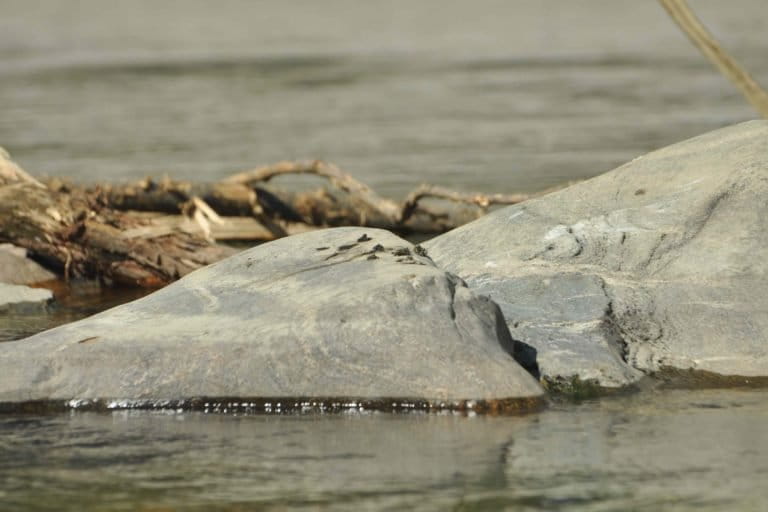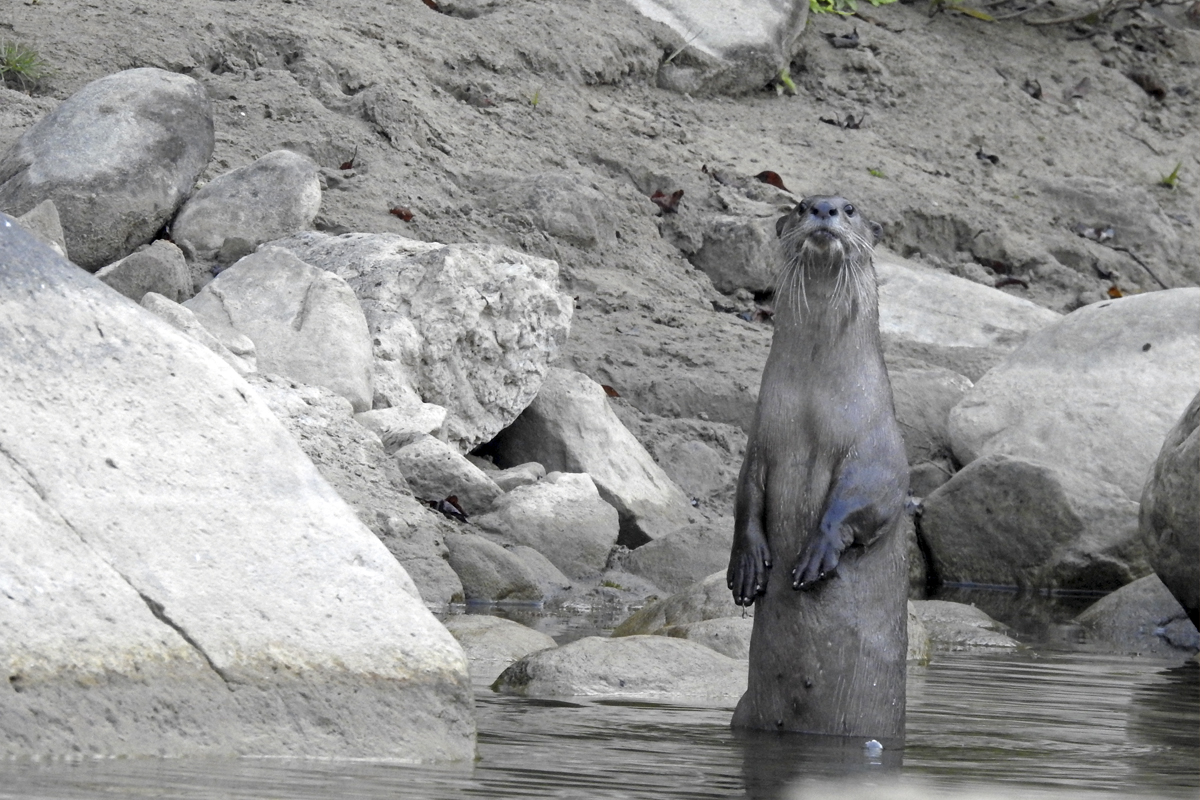- India has three otter species and they are becoming increasingly rare outside protected areas (PA), especially in the Himalayan region.
- Human-caused disturbance such as the construction of hydropower projects, sand mining and boulder collection harm the riverine habitats of otters that extend beyond PAs.
- According to wildlife biologists, connectivity between aquatic habitats outside PAs and involving communities in conservation are urgently needed.
“We thought otters were cats who came from the jungle and ate fish. We did not know much about otters,” recalls K. B. Rai, a homestay owner in East Sikkim, with a chuckle. Rai is a resident of Rolep village by the Rangpo chu, a tributary of the Teesta, a major river system of the eastern Himalayas.
He says he now knows more about the playful mammals, after he pitched in, in a camera trapping exercise to gather data about the presence and distribution of otters in the state, and saw them up close on the screen.
“If we have otters around our rivers, it means they are healthy,” said Rai, one of the local community members who has been helping Sunita Khatiwara, project officer, Sikkim government’s Forest and Environment Department, to monitor the cameras and share information on the presence of the semi-aquatic carnivores.
The monitoring is part of the ongoing department funded 2019-2020 otter survey on the tributaries of river Teesta and Rangit.
Khatiwara told Mongabay-India that due to the state’s mountainous terrain along with heavy monsoon flow, work along these rivers has a very small time window. “However, engagement of community members in the project has yielded good results,” she said with satisfaction.
Otters are shy, making direct sightings difficult, but scientists rely on indirect signs such as spraints (droppings), latrines (regular spraint sites), and tracks to look for them.
So far, the camera trap records and indirect sign surveys have produced evidence of the presence of mainly Eurasian otters (Lutra lutra) in Sikkim. In addition to the Eurasian otter, India is home to two other species of the total 13 otter species that occur globally. They are the small-clawed otter (Aonyx cinereus) and the smooth-coated otter (Lutrogale perspicillata).
As they become rare outside protected areas (PA), especially in northern India, including the Himalayan region, wildlife biologists stress on conservation of rivers and gathering data on the smaller but ecologically important group.

Khatiwara mentioned that there is a “faint mention” of the presence of otters in the biodiversity conservation literature of the Sikkim Forest Department. “There was no recent formal data on their sightings, distribution, and the species; the otter database was almost non-existent, except for a few anecdotal reports,” said a worried Khatiwara, observing that the high concentration of existing and planned hydropower projects and rampant sand-mining has impacted otter populations in the region.
There is no quantitative data available on how much habitat conducive to otters remains outside protected areas, according to veteran conservation biologist S.A. Hussain. Threats to otters such as habitat degradation, prey base depletion, poaching, and pollution are almost similar across their range but in the Indian Himalayan region, climate change is leading to reduced water levels and subsequent prey depletion in streams.
“This is directly causing habitats to shrink for the Asian small-clawed otter. Construction of dams and barrages particularly in the eastern Himalaya, are bringing about structural changes across otter habitats, disrupting the movement of otters and their prey,” said Hussain of the IUCN Otter Specialist Group.
Khatiwara echoed Hussain: “As we know, power companies are accused of not strictly following the environmental guidelines in constructing dams. The absence of fish ladder in many dams is among several issues raised by environmentalists, who say it has severely impacted fish migration, likely leading to a decline of prey for otters.”
“We need more scientific data to corroborate this association,” she said, adding that pharmaceuticals discharge in rivers in Sikkim is an emerging concern.

Disruption of connectivity of habitats
However, otters are incredibly resilient animals. Give them protection and healthy rivers with fish, and they will make a comeback as they did in Singapore and in the U.K., notes the Global Otter Conservation Strategy.
“People generally don’t know about otters which is why we have to involve communities in our activities if we want them to make a comeback,” emphasised Khatiwara.
In Uttarakhand in the western Himalayas, Sayanti Basak, a research scholar with Wildlife Institute of India, said that historically, the species were more widely distributed along rivers and streams in Uttarakhand, but now the scenario has drastically changed.
“High anthropogenic pressure has limited otters to certain undisturbed reaches of rivers within protected areas. Due to high anthropogenic pressure on riverine ecosystems, protected areas and the network of rivers and streams within them are a safe refuge for otter species. As a result, otters are becoming increasingly rare outside protected areas, particularly in north India, including the Himalayas,” Basak told Mongabay-India.
At the slightest hint of disturbance, they scurry inside dense vegetation for escape cover. This makes it difficult to conduct population estimations for the species, said Basak adding that even if they do occur outside PAs, their activity pattern is more nocturnal, and denning sites are not usually selected in disturbed areas.
“The most widely distributed species in India is the smooth-coated otter. Although most otter species are highly elusive, the smooth-coated otter can be spotted in some protected areas of Uttarakhand,” she noted.
A recent study on otter distribution in Uttarakhand’s four rivers (Kosi, Ramganga, Khoh, and Song) reports the detection of smooth-coated otters in the river reaches outside protected areas in the region (Corbett and Rajaji Tiger Reserves).

Given the important role being played by the protected areas in safeguarding threatened species within their boundaries but a proliferation of pressures outside of them, it is vital for conservation strategies also to target these ‘unprotected areas’ to maintain linear connectivity between otter habitats, said author Nishikant Gupta of International Centre for Integrated Mountain Development (ICIMOD), Kathmandu.
Otters occupy linear stretches of rivers and streams, typically not extending beyond 25 m from the water source. Dispersing otters, however, can travel longer distances in search of favourable habitats with sufficient prey abundance and this is why maintaining habitat connectivity across landscapes is important, elaborated Hussain.
India’s protected area network that covers five percent of India’s geographical extent caters mainly to terrestrial species, and portions of riverine ecosystems that fall within those boundaries receive direct protection. “We cannot cover an entire river system within a protected area boundary. It is simply not possible,” said Sayanti Basak, who finds otters extremely “charismatic.”
“In rivers outside the protected area network, we can take the community conservation approach where the local communities themselves are involved in protecting riverine ecosystems and otters,” said Basak, adding that policies that are inclusive of terrestrial and wetland ecosystems for conservation and management of an entire river basin are needed.
Apart from the lack of data on otter distribution, Kamal Medhi, landscape coordinator of the Western Arunachal Landscape Conservation Programme of WWF India, also pointed out the deficiency in PA approach of conservation, particularly in northeast India.
“In Arunachal Pradesh, 80 percent of the state is under forest area, and more than 60 percent of the state’s forests are under the rights and ownership of the local indigenous communities governed by traditional customary laws. The forest governance in northeast is different compared to the rest of the country and if you take the PA approach, then that covers only a small percentage of forests. So there has to be an approach where communities have to be partners,” Medhi added.
Medhi was part of a WWF team in Arunachal Pradesh, that had obtained the first-ever photographic evidence of smooth-coated otters in Nyamjang chu (river) valley in the state’s extreme west in 2014. A large part of the valley will likely be submerged by an upcoming hydroelectric power project. The sighting zone falls between two adjoining Community Conserved Areas. “Since then there have been sightings of otters in that area but no thorough research,” he rued.

Conserving rivers to protect otters
S.A. Hussain underscored that in India the focus is largely on glamorous species such as tigers and elephants. “We have very little priority for otters even though they are on the top of the food chain in aquatic ecosystems. Otters are always incidental, not the focus like tigers. If we focus on river conservation, otters will directly benefit,” Hussain said stressing that priority should be to conserve river and wetlands ecosystems.
With the steady drop in water quality of Himalayan rivers, environmental activist and water expert Himanshu Thakkar called out the “bumper to bumper” construction of hydropower projects (HP) in the Himalayas.
“In the Himalayas, the state of the rivers is pretty bad. HP projects in the Himalayas are coming up bumper to bumper and we had to fight so there could be a minimum distance between two projects and the Expert Appraisal Committee for River Valley and Hydro Power Projects agreed to leave a space of one km as tokenism,” Thakkar told Mongabay-India.
In 2016, in a submission to the Ministry of Environment, Forests and Climate Change on the draft of India’s National Wildlife Action Plan (2017-2031) SANDRP had pointed out that “it is disappointing to see that the plan deals with wetlands, framed in a way which excludes rivers.”
“Further, there is a provision in the Wildlife Protection Act (WLPA), 1972, that permission of the chief wildlife warden must be taken when planning projects on a stretch of a river that is outside PA when the project may have an impact on the flow on part of the river that is within a PA. Many times the permissions are taken post-facto,” added Thakkar, coordinator of South Asia Network on Dams, Rivers and People (SANDRP).
Banner image: A female otter in river Kolhu, Uttarakhand. Photo by Sayanti Basak.
